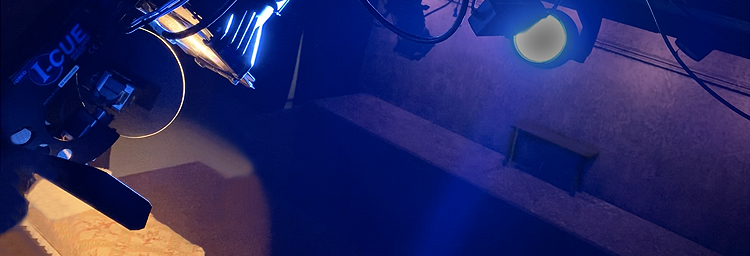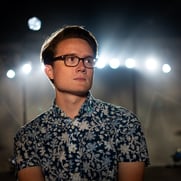 Edward Hansen is a lighting designer, artist, and visual storyteller working in theatre, installations, and live events. He has a passion for musical theater with additional experience lighting opera, new work theatre, and dance performance. Edward was the lighting designer for Dogfight by Peter Duchan with music and lyrics by Benj Pasek and Justin Paul. The performance was presented by Musical Theatre Repertory at USC inside the university’s Martin Massman Theatre. A small and technically challenging venue, the Martin Massman Theatre presented Hansen with numerous lighting challenges to overcome in order to bring this production of Dogfight to life. A pair of Rosco I-Cue Mirrors and a DMX Iris proved to be an excellent solution for Edward. He shared his experience below so that other small spaces with limited lighting and dimming inventory could see the benefit of these useful lighting tools.
Edward Hansen is a lighting designer, artist, and visual storyteller working in theatre, installations, and live events. He has a passion for musical theater with additional experience lighting opera, new work theatre, and dance performance. Edward was the lighting designer for Dogfight by Peter Duchan with music and lyrics by Benj Pasek and Justin Paul. The performance was presented by Musical Theatre Repertory at USC inside the university’s Martin Massman Theatre. A small and technically challenging venue, the Martin Massman Theatre presented Hansen with numerous lighting challenges to overcome in order to bring this production of Dogfight to life. A pair of Rosco I-Cue Mirrors and a DMX Iris proved to be an excellent solution for Edward. He shared his experience below so that other small spaces with limited lighting and dimming inventory could see the benefit of these useful lighting tools.
Dogfight is an enormous musical. We were constantly jumping around from location to location and sometimes right into musical numbers where we were nowhere specific at all. From the beginning of my design process, I knew that I needed to be able to specifically isolate characters in order to make them really pop out, both for the book scenes as well as within the large musical numbers.
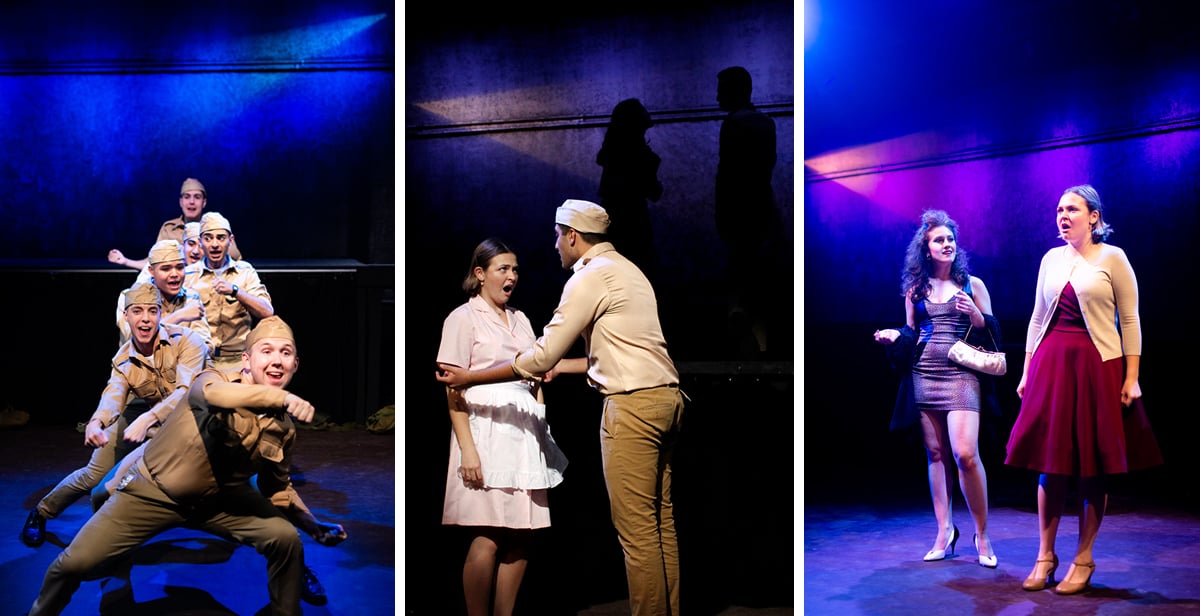 One of the major challenges of student theatre is often the limitations of the venue, and the Martin Massman theatre is no exception. The small blackbox was a great venue for Dogfight because of its intimate size. However, with only 24 dimmers and a little over 30 fixtures in the inventory, every lighting design decision needed to be very carefully thought out and every dollar of our budget needed to be spent as efficiently as possible.
One of the major challenges of student theatre is often the limitations of the venue, and the Martin Massman theatre is no exception. The small blackbox was a great venue for Dogfight because of its intimate size. However, with only 24 dimmers and a little over 30 fixtures in the inventory, every lighting design decision needed to be very carefully thought out and every dollar of our budget needed to be spent as efficiently as possible.
 The I-Cue enabled Edward to aim a special at the stage right staircase, in front of the riser center stage, and at the stage left drum set – all with one light.
The I-Cue enabled Edward to aim a special at the stage right staircase, in front of the riser center stage, and at the stage left drum set – all with one light.
This is where the Rosco I-Cue really came into play. We had two ETC Source 4 fixtures in the grid that were outfitted with I-Cues. Those two lights enabled me to have all the specials that we needed to isolate the performers – while only using two of our 24 dimmers. It was a cost-effective way to get a pair of high-quality moving light into the small space on a tight budget. Rosco’s I-Cue was an incredibly versatile tool in my kit for Dogfight, and it really helped to make this production come alive.
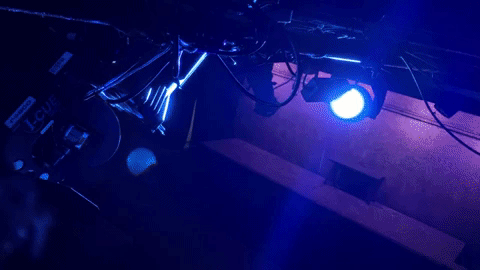 Cue 1 – light up on bed, Cue 2 – light out, Cue 3 – move mirror to bench in darkness, Cue 4 – light back up on new position. Repeat as-needed.
Cue 1 – light up on bed, Cue 2 – light out, Cue 3 – move mirror to bench in darkness, Cue 4 – light back up on new position. Repeat as-needed.
Having a light that’s able to quickly refocus to create different specials is truly indispensable. Between our quick tech schedule and limited lighting equipment, there wasn’t the time or resources to hang lots of individual specials. Plus, due to our dimmer limitation, nearly every light in the rig was two-fer’d or even three-fer’d, so it simply wasn’t feasible to have all the specials I would have wanted. The two I-Cues, however, enabled us to create specials and isolated spots wherever we needed, and we were able to jump around from scene to scene with ease.
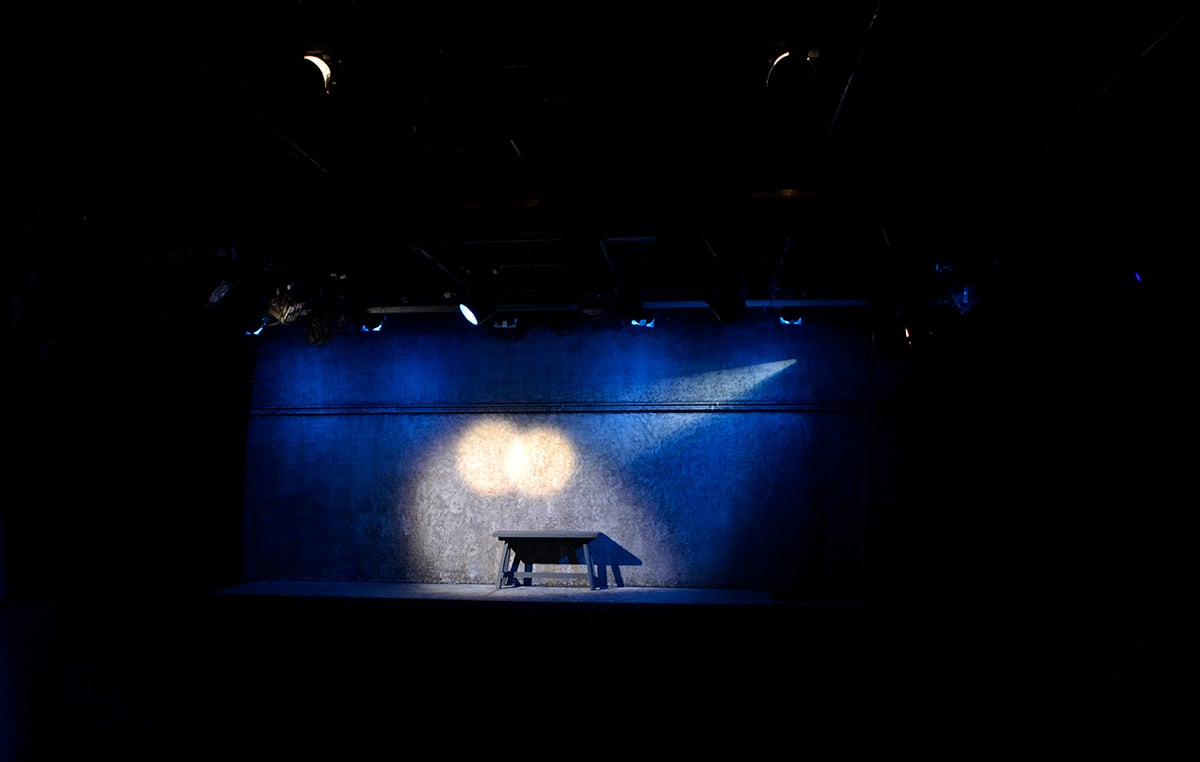 Edward used the I-Cue to position the specials, and a DMX Iris to shrink the beam for an intimate moment center stage.
Edward used the I-Cue to position the specials, and a DMX Iris to shrink the beam for an intimate moment center stage.
The I-Cue on its own is an incredibly versatile tool. For Dogfight, however, I knew that wouldn’t quite be enough. For some of the really intimate moments and musical numbers I knew I would need some very tight specials on people. The Rosco DMX Iris™ combined with the I-Cue allowed me to control the beam size of my special. That’s typically a feature you get on much more expensive moving lights. This is important to remember because when the mirror of the I-Cue moves the beam from one position to another, the photometrics will change and so will the beam size. Combining a DMX Iris with the I-Cue enabled me to create the beam size I needed for each scene.
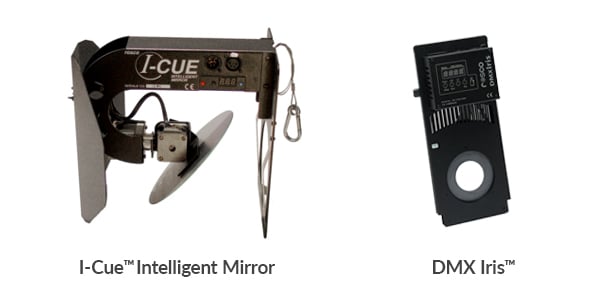 If you’d like to see more photos of Edward Hansen’s work, be sure to check out his website: www.edwardshansen.com. If you’d like to learn more about this production of Dogfight, visit the Musical Theatre Repertory at USC website: www.uscmtr.com. If you’re interested in learning more about the equipment Edward used inside the Martin Massman blackbox theatre, you can explore the I-Cue product page and the DMX Iris product page on the Rosco website for more information.
If you’d like to see more photos of Edward Hansen’s work, be sure to check out his website: www.edwardshansen.com. If you’d like to learn more about this production of Dogfight, visit the Musical Theatre Repertory at USC website: www.uscmtr.com. If you’re interested in learning more about the equipment Edward used inside the Martin Massman blackbox theatre, you can explore the I-Cue product page and the DMX Iris product page on the Rosco website for more information.

